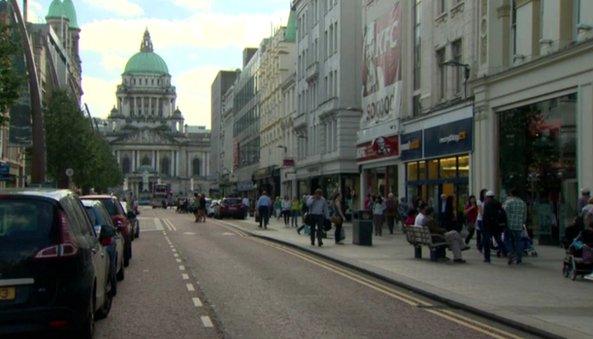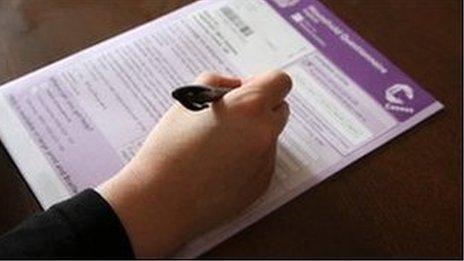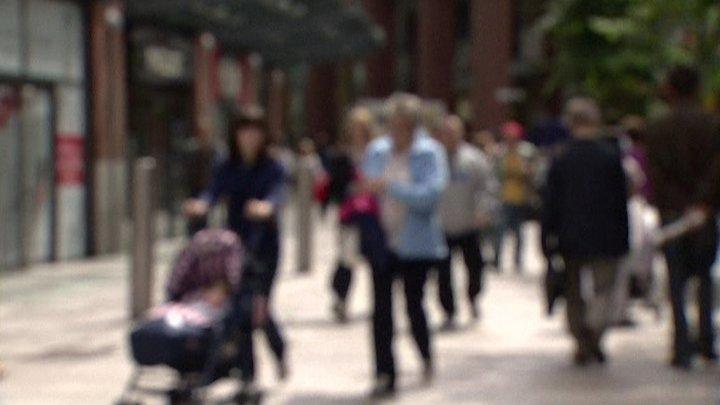Catholics now outnumber Protestants in Belfast
- Published

While the Catholic population in Belfast has risen to 49%, the Protestant population has dropped to 42%
Belfast is a city in transition, a divided city, divided by walls and divided even by the River Lagan.
On the east bank there is a largely unionist population, and on the west, a solidly nationalist and Catholic one, with significant sections of unionists in the north and south.
There is another difference.
The Catholic population is young with the number rising to 49%.
The Protestant population is older and passing away and has dropped to 42%.
Others such as new immigrants or those from mixed relationships with no fixed religion make up the rest.
Belfast is at a tipping point, according to the author of a new peace report, Dr Paul Nolan.
He underscores the connection between that shifting population and the flags row in Belfast.
He said Belfast changed over the past decade from being a majority unionist city to a city where the largest group is Catholic.
He said these figures from the 2011 census were finally published a week after the row erupted in Belfast City Council over the decision to restrict the flying of the union flag to designated days only.
'Human sensors'
He said those protestors did not read the report, but they acted out of its realities.
"Sometimes people can act like human sensors. They pick up what is happening underneath their feet. That earthquake that was happening," he said.
That earthquake is one of the themes of peace monitoring report. It also describes young Protestant men, a quarter of whom are jobless, as a seedbed for trouble. This is because of alienation and the risk of being drawn into a cultural conflict.
Loyalist community worker, Gerald Solinas, who also represents the Ulster Political Research Group, is critical of the report.

A bandsman at the Twaddell Avenue protest camp in north Belfast
He dislikes the language and claims its conclusions are too simplistic. He thinks words such as "tipping point" are dangerous.
He points out that nationalists face similar problems of deprivation and problems around jobs, housing and regeneration.
Cultural warfare
He often speaks for the protestors at the Twaddell Avenue camp in north Belfast, a symbol of loyalist fury over the parading and flags.
Mr Solinas acknowledged there is a sense of cultural warfare.
"The taking down of our flag at city hall, the demonization of our culture in parading is all things very true to our hearts. It's basically similar to someone coming into your house, rearranging the furniture. It just makes you feel very uncomfortable," he said.
While Catholics still suffer deprivation, Catholic schools are excelling, providing a route out of poverty.
Dr Nolan pointed to a confident nationalist population with a growing middle class, contrasting this with what is happening on the unionist Protestant side.
He said even if politicians had agreed the Haass proposals, it would not have solved the difficulty facing society in Belfast.
"This problem was still going to bubble up because what we have is inequality," he said.
"We've got a section of our population - young Protestant males - who have no routes out of their poverty. And they experience it as inequality. They experience it as alienation and it will erupt."
Mr Solinas and Dr Nolan agree that there is a lack of political leadership and vision at Stormont.
Brian Feeney, an Irish News columnist, said unionist politicians are pretending the changes are not happening while fighting a losing battle.
"It's been like King Canute. They are trying to force back the nationalist tide and it has completely failed," he said.
"All the unionist politicians know these statistics quite well. They know exactly where it is heading and they know the only outcome can be accommodation and reconciliation. And as it points out in the report there is peace, but no attempt at reconciliation whatsoever."
Belfast artists are reflecting the realities. Joe McWilliams, from the north of the city, has put on canvass vivid images of marching loyalists outside St Patrick's Church. But another artist, Susan Hughes from the south of the city, has just opened an exhibition at Stormont called quiet peacemakers.
Quiet peacemakers
The portraits include the late Fr Alec Reid and Lesley Carroll, a Presbyterian minister in Belfast.
She said there is not enough acknowledgement of quiet peacemakers and not enough unity among them.
"So maybe we need to get ourselves together and make sure we know what each other is doing. That support and vision that comes from each other would make a big difference. And that makes stronger voice to those in leadership," she said.
There are young people working to bridge the divide through prayer, music and art. Among them is Ashley Holmes from Youth Initiatives. She is 26 and has been, she says, doing cross-community work since the age of 12.
She said young people can be disappointed by a lack of support from politicians, their parent's stories and negative language.
"Our young people are feeling like they are holding everybody else's past on their shoulders. They are feeling they are trying to move forward and trying to be positive, but there are certain things that are holding them back," she said.
Her vision for the city? Investment, shared space and that a new light would shine on it.
There is more on this story on The View, which is available here on the BBC iPlayer.
- Published16 May 2013

- Published11 December 2012
